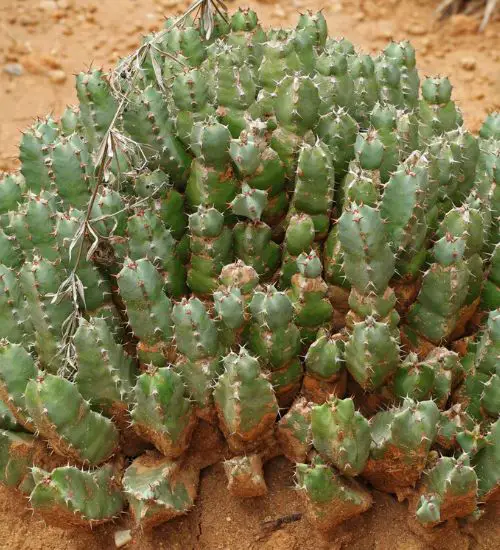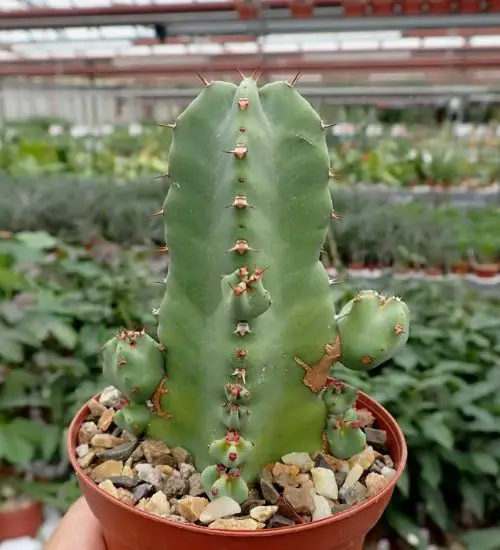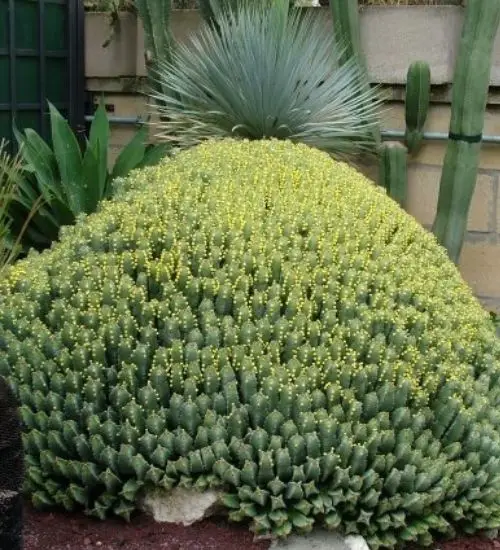Sun: full sun to partial shade
Water: Below average watering needs for a succulent
Temperature: Zone 9a from 20° F to 25° F (-6.7 ° C to -3.9° C) to Zone 11b from 45° F to 50° F (7.2° C to 10° C)
Winter Survival: Not cold hardy
Propagation: stem cuttings
Flower:
Flower Type: Yellow
Toxic: Toxic to humans and animals
Dormant: winter
Space Requirement: Outdoors
Common Problems: No major pests, Plants may rot if overwatered
Where to buy Euphorbia Resinifera?
Basc Care for Euphorbia Resinifera
Watering
Regular watering period should be every 2 weeks
You can water your succulent more than often in extreme conditions but make sure that the soil is completely dry before watering your succulent again.
Fertilizing
Only feed this succulent during its active growing seasons which means winter. Use the right fertilizer applied in the right amounts. Applying half-strength balanced fertilizer every month or so is recommended for optimal results.
Do not fertilize during winter as the plant is dormant.
Sun & Location Requirements for "African Spurge. Euphorbium. Resin Spurge."
Euphorbia Resinifera requires full sun to partial shade. It's best to keep it in an area of your garden or home that gets plenty of bright, indirect sunlight throughout the day. When temperatures are too hot and direct sunlight is too intense, try moving "African Spurge. Euphorbium. Resin Spurge." to a shadier spot for part of the day.
As per this succulent profile, it is only able to stay healthy when the environment temperature is above the range of zone 9a from 20° F to 25° F (-6.7 ° C to -3.9° C).
When temperatures drop below freezing, it is important to take precautions to protect Euphorbia Resinifera from the cold. Insulating and providing adequate drainage for the plant are key elements in helping it survive winter weather. Wind and sun exposure should also be minimized to prevent frost damage.
Any succulents in the group will need a large space to grow. You should place your pot outdoor. Since this plant needs a lot of space than other succulents, you should consider not planting them together with other succulents/plants.
Euphorbia Resinifera also benefits from some indirect light throughout the day as well, so make sure you give it enough space to soak up light without becoming too exposed to heat.
Propagation
Propagating Euphorbia Resinifera by stem cuttings is an easy and fun way to increase your collection of these unique houseplants. When propagating, it’s important to choose healthy stems from existing plants that are at least two inches long and have several leaves attached.
Toxicity

Euphorbia Resinifera is a highly toxic succulent that should be treated with extreme caution to avoid serious health risks. If ingested, it can lead to severe gastrointestinal distress, respiratory problems and even death. It is best to keep this plant away from homes or gardens where humans or animals reside.
Pests and Diseases
Euphorbia Resinifera is not affected too much by common pests and diseases like most of the other succulents.


